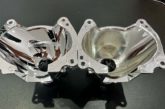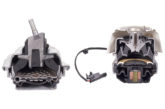
An EGR valve controls and regulates a proportion of the exhaust gas into the inlet of the engine. The main reason for this is to reduce Nitrogen Oxide (NOx) levels at the combustion stage. When the air/fuel mixture is burnt in the combustion chamber the formation of Nitrogen Oxide increases as the temperature rises.
Re-circulating a proportion of the exhaust gas back into the air/fuel mixture lowers the combustion temperature in the cylinder, reducing the rate of NOx formation. Many EGR valves now incorporate a cooler to decrease the temperature of the exhaust gas.
Early designs used vacuum to operate the valve mechanism whereas most modern types are electronically operated by solenoids or motors.
Exhaust gas flows through the valve and most of the time it is diverted through the cooler where the gas is cooled by the engine coolant. The cooler bypass (operated by a vacuum diaphragm) is only in the closed position when the engine is cold. This helps to get the engine up to the optimum operating temperature quickly. The motor cam moves the re-circulation valve in or out to control how much exhaust gas is allowed back into the inlet. An electronic circuit board uses a positional sensor to provide the ECU with accurate feedback as to the position of the valve and the amount of exhaust gas that is being re-circulated.
Reasons for failure
 The most common failure is carbon build-up inside the EGR and cooler. This is inevitable over a long time period, but is significantly increased with city driving and short runs. Problems with the particulate filter can also cause excessive carbon build-up.
The most common failure is carbon build-up inside the EGR and cooler. This is inevitable over a long time period, but is significantly increased with city driving and short runs. Problems with the particulate filter can also cause excessive carbon build-up.
Other problems are often related to mechanical wear. The signal fed back to the ECU about the valve position has to be accurate so any variations outside of normal tolerance are detected by the ECU and error codes are then logged. The cooler bypass can also sometimes fail or develop external leaks.
Diagnosis and testing
Valves can fail in the open position, resulting in poor and uneven idle speed. There are many cases, however, where modern EGRs will show no physical symptoms other than a fault code.
The ECU detects even a small deviation from normal parameters resulting in a warning light on the dashboard and, in some cases, puts the ECU into ‘limp home’ mode where engine power is significantly reduced.
Most re-manufacturers will not be able to adequately test for all failure modes – some only test passively, leading to a high warranty return rate. At SMPE we’ve developed an active test set-up which ensures full parametric performance in all conditions. This has helped us to understand that replacing the electronic circuitry is essential to long term reliability and function.









